How can game requirements (loading screens, save points, deaths...) improve the experience; PART 2
In this part, I will study how can saving mechanics actually improve the game experience and be used as

In that second and final part of my study on the use of video game mechanics to improve the experience, I will talk about a mechanic which is very specific to video games: saving your progress.
The idea is deeply linked to that of failing and trying again explored in my previous entry. Indeed, saving your game is the powerful net that turns the death of your character into nothing but a small discomfort.
Today, thanks to technological progress, games have been liberated from the need of having specific savepoints. This, added to the wish to improve the player's comfort by allowing him to save whenever and wherever he wants, has pretty much erased saving mechanics from most games today. We have come to the point of having games like the 3D Fallout which autosave every single time you move to a new area.
Of course, autosave, coupled with the ability to save at any point, means a lot of comfort to the player. No more 'yes mom I'll come and eat as soon as this cutscene is over and I can save!".
The problem is that this takes away any feeling of danger you can have in a game. Why should I be careful while exploring this dangerous cave, if the last save point is ten meters behind me? Why would I care about this choice if I got the option of saving right before it?
Damn you, lava!
You can have a challenging game, but if nothing is at stake, then the player won't care about losing or making bad decisions, since it will only make them lose a couple of seconds. After all, wasn't a part of the thrill of exploring a new cave in minecraft the risk that you could, at any moment, fall into a lava pit and lose these 5 diamond pick you just crafted?But this "no loading you last savefile" policy isn't what I advice either. Is problem is that it can make the player, at best, frustrated, at worst, downright infuriated against the game. And this is not what you want.
Of course, some games - minecraft, animal crossing, mount and blade) do it right, but these games make this principle the core of their design, and are almost entierly built around it.
So, this leaves us with a third solution: specific save points. This mechanic is pretty simple: only being at a certain place or in front of a certain item allows you to save. As said earlier, this mechanic can be pretty annoying for the player, who can only save at specific moment. If you have to stop the game very quickly and are stuk in a battle or a cutscene, you can say goodbye to all your progress. This also applies to some cruel games where, if you die, you are sent back to the previous savepoint (I have never finished Tales of Vesperia because I couldn't gather the couage to get back into it after dying to a boss after playing four hours without saving...).

Gotta replay it someday
Well actually, there was one game that had found a very good solution to this problem. Here enters Castlevania: Arya of Sorrow.In that game, you could only save at very specific places, the sanctuaries. So, what happened if you had to stop the game for whatever reason? You could just put it in "sleep" mode, where you saved the game, and could start back from this exact place any time you wanted. But the trick was that this save file would erase itself the first time you loaded it, which meant that you could not use it to save right before a boss battle and load it every time you lost. This is a very interesting mechanic, and I find it kinda sad that very few other games use it nowadays.
But let's get back to the core subject: how to use these savepoints to improve the game experience.
In their battle for immersion, many designers have tried to make the savepoints fit in the universe: in Breath of Fire 2 you saved by telling your story to a statue of the Dragon God, in Resident Evil 4 it was by typing on a typewriter (the oldest games even required an ink ribbon for each save), and in Silent Hill you save by writing notes on your diary. Of course, no one wonders why there's a bunch of guys talking to a statue, or why are these two men lost in the most dangerous places of the world taking the time to write down everything they have been doing since they got there.
On the other hand, you have developpers who simply don't care. Savepoints can be small lights on the ground, floating crystals or whatever you want. Actually, this even makes things simpler for the player, since he won't have to look for a specific NPC or item: "see that thing there that seems completely out of place with no one reacting to it? Yeah, that's the save point!". They are items completely out of the game universe, that are here only for the player, not even for the characters (otherwise, the easiest way for the bad guys to win would be destroying every dragon statue or typewriter in existence).
And that is what is important: savepoints are for the player. They're a way to communicate to him about the state of the game. Since their position is rarely random, running into a savepoint is something actually meaningful for the player. They are the best way of showing him that he is actually progressing through the game.
To get back to the Tales of Games, savepoints are usually in 3 different types of places: in a city, at the entrance of a dungeon, and right before the boss of the dungeon. Basically, they're here whenever something important will happen. The player knows it, and this is what actually sets the rythm for the adventure. And it is a good way for developpers to motivate him to get back into the game. Indeed, savepoints are critical points, since you know that this is where the players are the most likely to stop playing (and maybe never start again). So, if the player isn't expecting anything special after the savepoints, odds are higher that he might actually not start the game again. Put a savepoint right before important cutscenes or other elements that make the game's story progress, and you'll end up with the player actually being happy of seing a savepoint. Reminds you nothing?

Pavlov's player
Hum... anyway. There are other ways you can use this savepoint = something important conditionning to improve your game. For example, if your game requires important choices to be made by the player, he will expect being able to save before these choices. This will provide him with some sort of safety net, and he won't really care about these choices since he'll still be able to load the last save file. Now what if you put a choice before a savepoint, which is himself before the moment when the consequences of this choice will happen? This time, since making the choice then reloading won't be a viable strategy anymore, you will lead the player into really thinking about the choices, and really getting involved in the story and his character.
Now you run the risk of frustrating your player, if he believes he has made the wrong choice. So, you should use this strategy very early in the game with choices with no very important yet very easily seen consequences, to quickly send the message to your player, before eventually switching to a more traditionnal saving pattern.

Metroid Prme Savepoint
Now, there's another particularity of savepoints I want to explore in this article. As said earlier, save points are a way to create a rythm in the game progression. Every time your player reaches a new save point, he knows he has taken a new step in the game. And there is one game which makes a good use of this: Metroid Prime. I am not saying other Metroid games don't do this, but I am using this one as an example.In this game, savepoints are specific room which, in addition to saving replenish your energy and sometimes ammunition. These rooms are usually the only ones providing you a feeling of safety in this game where you are lost alone on a dangerous planet where everything is out there to kill you. And since this game heavily relies on exploration, players end up adopting the same playing patterns, made of goings and comings from and to these savepoints. This is a great way to get your player to do what you want them to do in a game with such a complex map. And once he grows confident enough to go far away enough from his last savepoint, you can reward him by a new savepoint, which will act as a new exploration base for him.
Hope you enjoyed the read, see you next week for the third and last article of this series!
Read more about:
BlogsAbout the Author(s)
You May Also Like







.jpeg?width=700&auto=webp&quality=80&disable=upscale)








